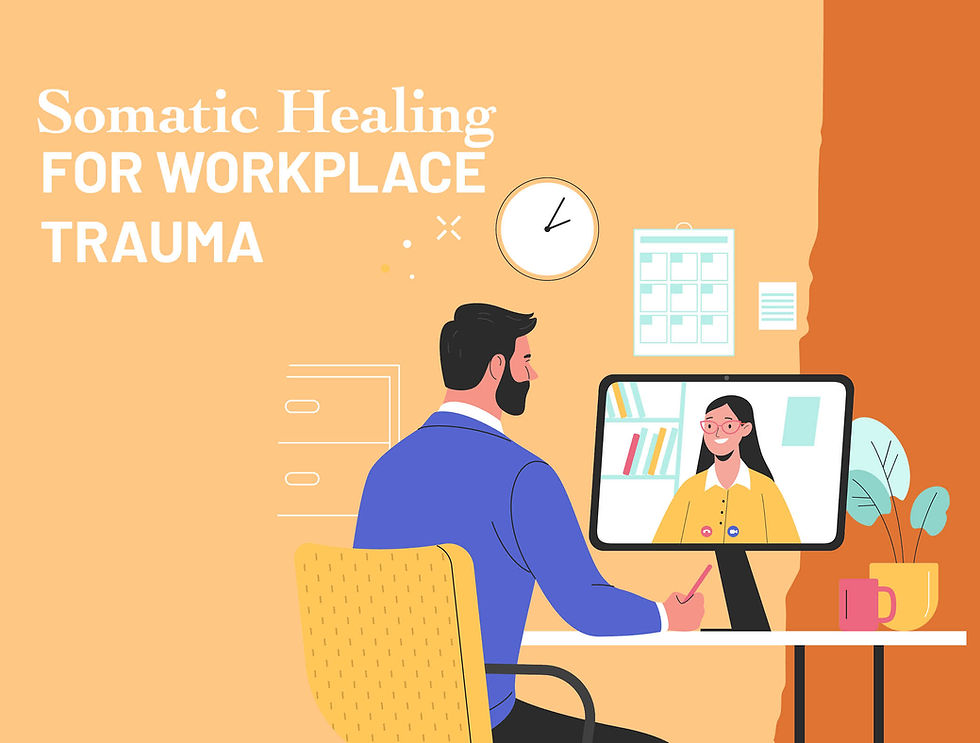Somatic Experiencing™ offers a pathway to healing workplace trauma that honors the wisdom of the body and paves the way for lasting recovery.

In today’s high-pressure work environments, workplace trauma is an increasingly prevalent issue. Whether it stems from chronic stress, bullying, harassment, discrimination, or high-stakes crises, the impact of such experiences can be profound, affecting not only the mental and emotional well-being of professionals but also their physical health and productivity. Traditional approaches to managing workplace trauma often focus on cognitive and psychological interventions, but there is growing recognition of the role that the body plays in processing and healing trauma. This is where Somatic Experiencing™ (SE™) comes into play.
Understanding Somatic Experiencing
Developed by Dr. Peter Levine, Somatic Experiencing is a body-oriented therapeutic approach aimed at relieving the symptoms of trauma and chronic stress. It is based on the idea that trauma is not just a psychological event but also a physiological one that is stored in the body. SE works by helping individuals tune into their bodily sensations and release the energy and tension associated with traumatic experiences. This process allows the nervous system to return to a state of balance and regulation, facilitating healing and recovery.
How Workplace Trauma Manifests in the Body
Workplace trauma can manifest in various ways, such as anxiety, depression, burnout, and even physical ailments such as headaches, gastrointestinal issues, and muscle tension. The body’s response to trauma involves a fight, flight, or freeze reaction, which, when unresolved, can lead to a state of hyperarousal or dissociation. Professionals may find themselves feeling constantly on edge, unable to focus, or emotionally numb. Traditional talk therapy can be beneficial, but it often doesn’t address the physical dimension of trauma.
The Role of Somatic Experiencing in Healing Workplace Trauma
Somatic Experiencing provides a unique and powerful approach to addressing the bodily component of trauma. Here’s how it can help professionals who have experienced workplace trauma:
Reconnecting with the Body: SE encourages individuals to become more aware of their bodily sensations. By paying attention to the physical cues associated with stress and trauma, professionals can begin to understand how their bodies have been affected and learn to recognize early warning signs of distress.
Releasing Stored Tension: Trauma can cause the body to become stuck in a state of tension or arousal. Through gentle, mindful exercises, SE helps individuals release this stored tension, allowing the nervous system to reset and return to a state of equilibrium.
Building Resilience: By working through traumatic experiences in a controlled and supportive environment, individuals can build greater resilience and coping mechanisms. This process helps professionals feel more empowered and better equipped to handle future stressors.
Promoting Emotional Regulation: SE helps individuals learn how to regulate their emotional responses. By understanding the link between bodily sensations and emotions, professionals can develop strategies to manage their reactions more effectively, reducing the risk of burnout and emotional overwhelm.
Facilitating Recovery: Somatic Experiencing doesn’t require individuals to relive their trauma through detailed recounting. Instead, it focuses on the present-moment experience and the sensations that arise. This can make the healing process feel safer and more accessible for those who may find traditional talk therapy retraumatizing.
Integrating Somatic Experiencing into Professional Life
Incorporating Somatic Experiencing into one’s life doesn’t mean setting aside large amounts of time for therapy. SE can be integrated into daily routines through simple practices such as mindful breathing, body scanning, and grounding exercises. These techniques can be used during breaks at work or at home to help professionals stay connected to their bodies and manage stress more effectively.
While Somatic Experiencing offers valuable tools for self-regulation and healing, working with an SE practitioner can provide deeper and more tailored support. These professionals are trained to guide individuals through the process safely, helping them navigate the complex sensations and emotions that arise during healing.
Workplace trauma can have far-reaching effects on professionals, impacting both their personal and professional lives. Somatic Experiencing offers a holistic approach to healing, recognizing the intricate connection between the mind and body. By helping individuals release stored trauma and build resilience, SE can empower professionals to recover from their experiences and move forward with greater balance and well-being.
As more organizations recognize the importance of addressing workplace trauma, incorporating body-oriented approaches like Somatic Experiencing can play a crucial role in creating healthier, more supportive work environments. For professionals who have been affected by workplace trauma, SE offers a pathway to healing that honors the wisdom of the body and paves the way for lasting recovery.
Workplace Peace Institute is an organization systems design and research firm that is singularly focused on creating workplace cultures where people thrive. Workplace Peace Institute supports small to mid-sized businesses in optimizing employee engagement, maximizing organizational productivity, and improving profitability by infusing human security and dignity as foundational attributes of their business model. Workplace Peace Institute offers a variety of services to support professionals in navigating complex challenges so they can achieve their individual potential. We are singularly focused on creating workplace cultures where all people thrive, which is why we are committed to helping you thrive.
Comments